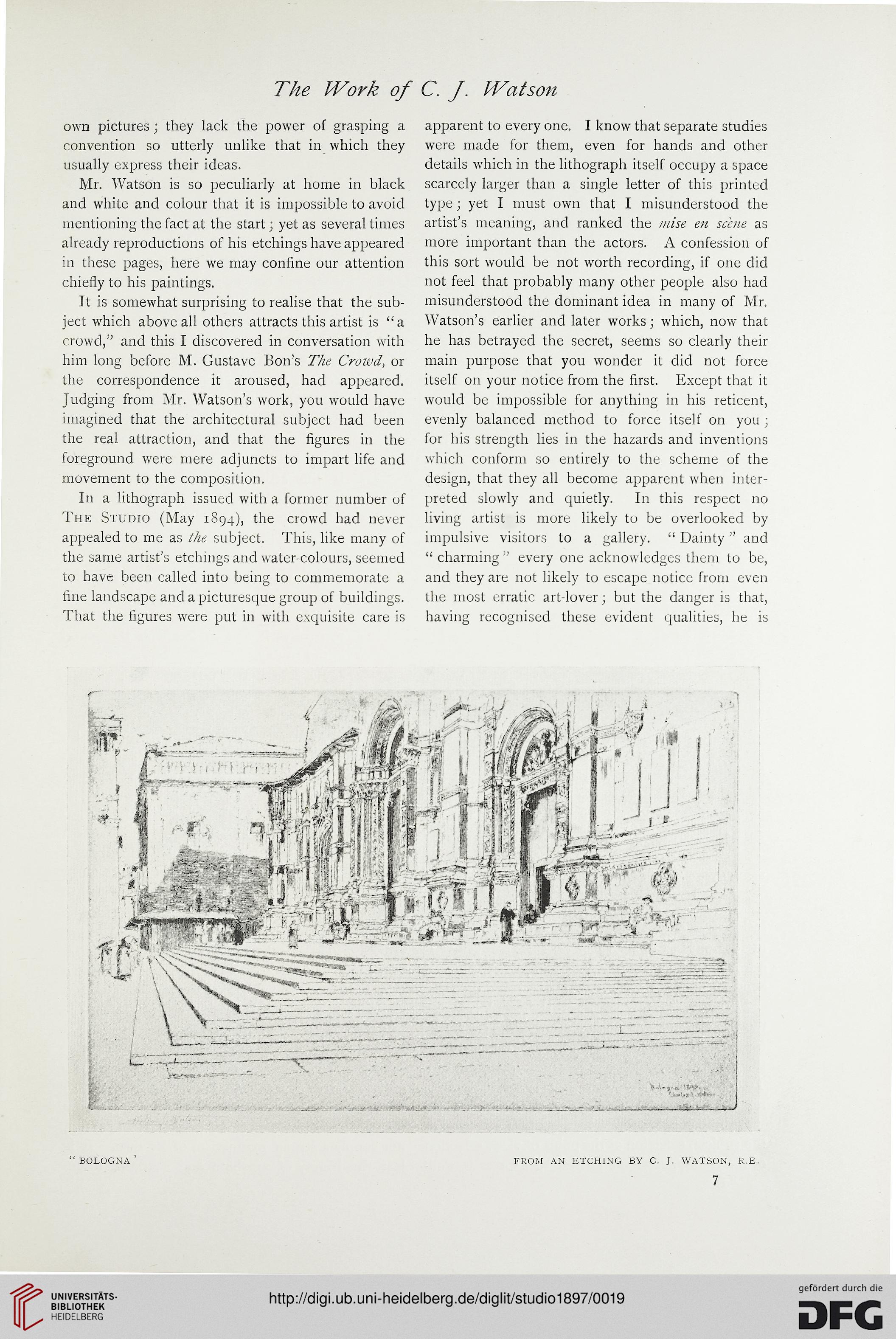The Work of C. J. Watson
own pictures ; they lack the power of grasping a
convention so utterly unlike that in which they
usually express their ideas.
Mr. Watson is so peculiarly at home in black
and white and colour that it is impossible to avoid
mentioning the fact at the start; yet as several times
already reproductions of his etchings have appeared
in these pages, here we may confine our attention
chiefly to his paintings.
It is somewhat surprising to realise that the sub-
ject which above all others attracts this artist is "a
crowd," and this I discovered in conversation with
him long before M. Gustave Bon's The Crowd, or
the correspondence it aroused, had appeared.
Judging from Mr. Watson's work, you would have
imagined that the architectural subject had been
the real attraction, and that the figures in the
foreground were mere adjuncts to impart life and
movement to the composition.
In a lithograph issued with a former number of
The Studio (May 1894), the crowd had never
appealed to me as the subject. This, like many of
the same artist's etchings and water-colours, seemed
to have been called into being to commemorate a
fine landscape and a picturesque group of buildings.
That the figures were put in with exquisite care is
apparent to every one. I know that separate studies
were made for them, even for hands and other
details which in the lithograph itself occupy a space
scarcely larger than a single letter of this printed
type; yet I must own that I misunderstood the
artist's meaning, and ranked the mise en scene as
more important than the actors. A confession of
this sort would be not worth recording, if one did
not feel that probably many other people also had
misunderstood the dominant idea in many of Mr.
Watson's earlier and later works; which, now that
he has betrayed the secret, seems so clearly their
main purpose that you wonder it did not force
itself on your notice from the first. Except that it
would be impossible for anything in his reticent,
evenly balanced method to force itself on you •
for his strength lies in the hazards and inventions
which conform so entirely to the scheme of the
design, that they all become apparent when inter-
preted slowly and quietly. In this respect no
living artist is more likely to be overlooked by
impulsive visitors to a gallery. " Dainty " and
" charming " every one acknowledges them to be,
and they are not likely to escape notice from even
the most erratic art-lover; but the danger is that,
having recognised these evident qualities, he is
"BOLOGNA
FROM AN ETCHING BY C. J. WATSON, R.E.
7
own pictures ; they lack the power of grasping a
convention so utterly unlike that in which they
usually express their ideas.
Mr. Watson is so peculiarly at home in black
and white and colour that it is impossible to avoid
mentioning the fact at the start; yet as several times
already reproductions of his etchings have appeared
in these pages, here we may confine our attention
chiefly to his paintings.
It is somewhat surprising to realise that the sub-
ject which above all others attracts this artist is "a
crowd," and this I discovered in conversation with
him long before M. Gustave Bon's The Crowd, or
the correspondence it aroused, had appeared.
Judging from Mr. Watson's work, you would have
imagined that the architectural subject had been
the real attraction, and that the figures in the
foreground were mere adjuncts to impart life and
movement to the composition.
In a lithograph issued with a former number of
The Studio (May 1894), the crowd had never
appealed to me as the subject. This, like many of
the same artist's etchings and water-colours, seemed
to have been called into being to commemorate a
fine landscape and a picturesque group of buildings.
That the figures were put in with exquisite care is
apparent to every one. I know that separate studies
were made for them, even for hands and other
details which in the lithograph itself occupy a space
scarcely larger than a single letter of this printed
type; yet I must own that I misunderstood the
artist's meaning, and ranked the mise en scene as
more important than the actors. A confession of
this sort would be not worth recording, if one did
not feel that probably many other people also had
misunderstood the dominant idea in many of Mr.
Watson's earlier and later works; which, now that
he has betrayed the secret, seems so clearly their
main purpose that you wonder it did not force
itself on your notice from the first. Except that it
would be impossible for anything in his reticent,
evenly balanced method to force itself on you •
for his strength lies in the hazards and inventions
which conform so entirely to the scheme of the
design, that they all become apparent when inter-
preted slowly and quietly. In this respect no
living artist is more likely to be overlooked by
impulsive visitors to a gallery. " Dainty " and
" charming " every one acknowledges them to be,
and they are not likely to escape notice from even
the most erratic art-lover; but the danger is that,
having recognised these evident qualities, he is
"BOLOGNA
FROM AN ETCHING BY C. J. WATSON, R.E.
7




